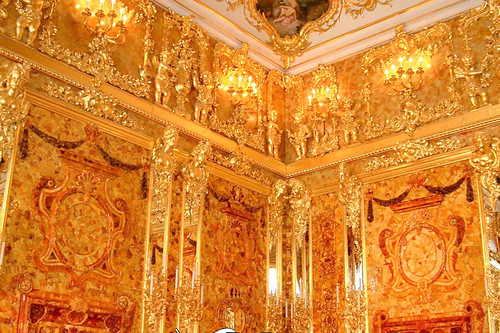
The restored Amber Room at Catherine I of Russia’s palace is decorated in baroque panels of amber with gold leaf and mirrors. Photo by Larry Koester on Flickr.
Ah, amber. It’s one of the most essential notes in perfumery, yet it’s totally imaginary – a fantasy note. Amber is named after the semi-precious natural amber, or fossilized tree sap, because they share the same rich honey-molasses hue.
There’s something about the feeling tone of amber: its warmth and richness, that makes many of us go all weak in the knees and grabby-hands. Ancient peoples revered the fossilized sap as a precious gem for its rich luster – and occasionally went baroquely insane with it, as seen above in the reconstruction of the 18th Century Amber Room (yes, constructed of real amber!) at the Catherine Palace of Tsarskoye Selo near Saint Petersburg.
But there is no amber in perfume “amber.”
Instead, amber is usually constructed around deliciously soft balsamic notes: rum-like and boozy sweet vanilla, leathery labdanum, and occasionally another resin, such as the creamy soft benzoin. The overall effect is rich and comforting, and the foundation of most oriental perfumes and some rich florals to help “fix” the more volatile flower notes.
Amber has many variations. I’m beginning with the accord in Mandy Aftel’s book, Essence & Alchemy. Her ratio:
- Benzoin absolute 20
- Labdanum absolute 5
- Vanilla absolute 1
How does it smell? Rich, dark, and sticky sweet – mouth-watering like a piece of dark toffee or caramel, yet not quite edible due to the faint leathery note in the labdanum. It’s used as a component of the perfume Alchemy in the same book, and I look forward to trying it in other compositions (and variations) too.
Hi! I’m dying to make my own amber accord and have been researching like crazy the ingredients and trying to find good recipes. As you know people play it close to the vest with amber so it’s not easy. The most readily available are Mandy’s and White lotus’s which have significant differences. I’m wondering if you have created both and which you think is better and if you have any recommendations for tweaks. Also I intend to use an oil base versus alcohol and from the Eden website they state that their Benzoin does not dilute in oil. Do you have any experience with their Benzoin?
LikeLike
Hi! Oh I totally I understand! I have created Mandy’s Amber Accord but not White Lotus’s – I made the alcohol version, not the oil-based version. Mandy’s is definitely really lovely! I highly recommend. As for Benzoin…I used White Lotus’s Benzoin, which is diluted in alcohol (which is why I made the alcohol-based blend rather than oil-based). It is the same issue with Eden’s – which is also an alcohol dilution. I haven’t hunted for Benzoin in awhile, but I think it’s hard to find undiluted because it’s such a viscous resin. Good luck to you! Let me know if you find a Benzoin that isn’t alchol-based! I suspect if you want to make an oil-based Amber you might need to modify the materials you use.
LikeLike
Thanks for your reply!
So Ive only ever worked with oil based perfumes and have been very hobbyist about it and not technical in my making…Ive decided to get more serious about it because I love it so much and am now looking to doing alcohol perfumes which solves the benzoin problem lol. I had a technical blending question that I just sent you in a different post and I think it posted but I’m not sure so I’m pasting below as well.
Hi! ok so I’m new at this and have been messing around in drops, but I have a question that may sound silly but alas I am an English teacher confused by numbers soooooo, I think you get me.
Everything I’ve read says to dilute materials to 10% (depending on the material) and then blend. OK got it. Once the blend is right I need to complete the perfume by adding the alcohol and that should be at 10% fragrance to alcohol lets say for ease. Here is where I’m confused. Do I need to take the blend I made of my materials that are pre-diluted (lets say that accounts to 10 drops total liquid) and add 90 drops of alcohol to make 100 total drops, 10% of which are the diluted fragrances. In my mind this make the dilution not actually 10% if you count the alcohol used in diluting the materials first. OR do I make a whole new blend using the full strength original materials in the same proportions as the prediluted test and then dilute that to 10% or whatever strength you want the perfume to be? uuughhh this seems like it’s so complicated to me, sorry math people out there who are cringing at my limited number sense brain power… lol
Also, you’ve said Mandy doesn’t dilute first, she blends the raw materials. So with this I am wondering if you don’t dilute first, will you really be able to smell what your perfume will be as a blend considering a lot of materials you can’t get the full profile of until its diluted. Does she do this just because her nose is so well trained at this point or am I wrong totally and you will still smell the perfume profile working undiluted?
Thanks!!!
LikeLike